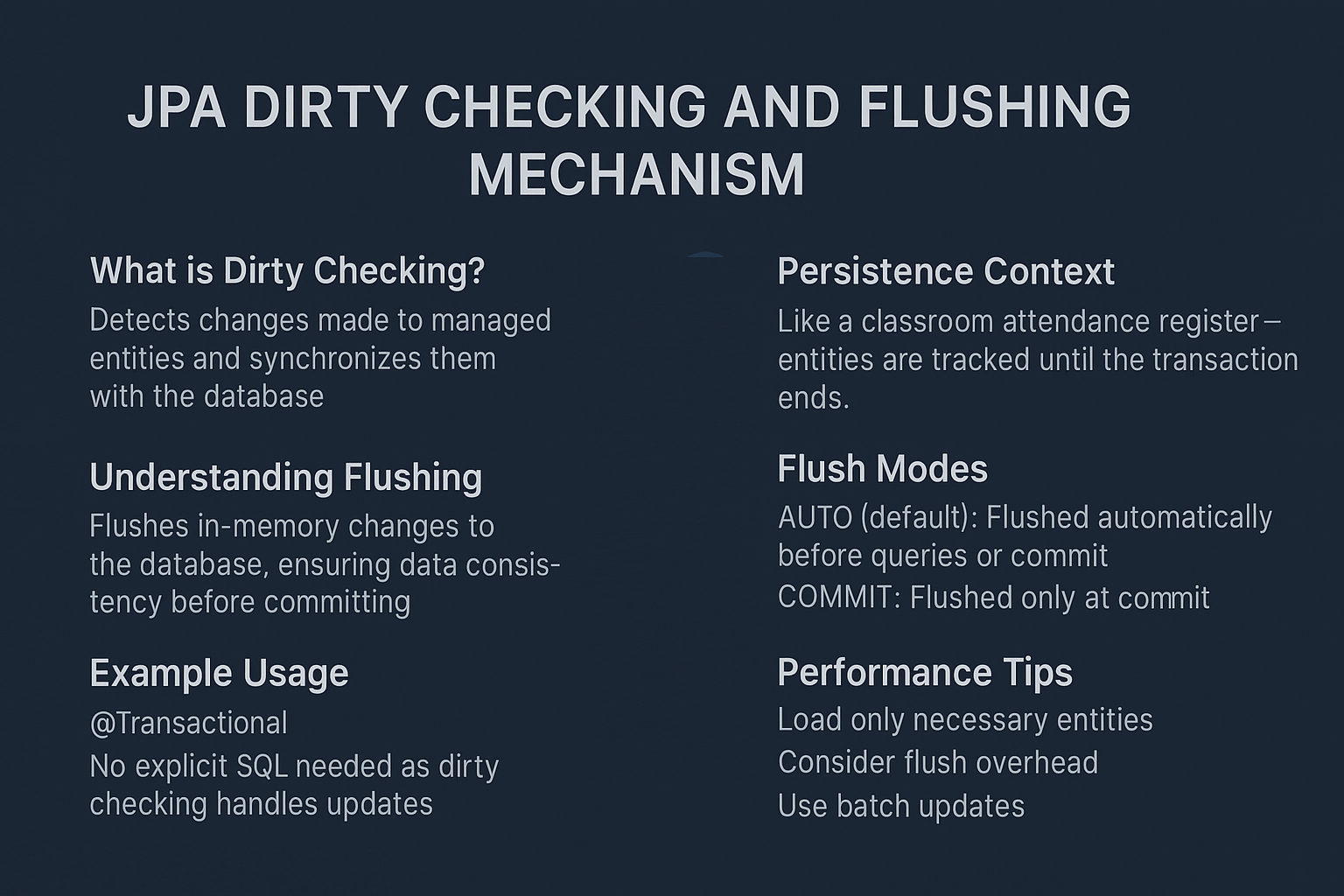One of the most powerful features of JPA (Java Persistence API) is that it automatically synchronizes entity state with the database without requiring manual SQL updates. This behavior is driven by dirty checking and the flushing mechanism.
- Dirty Checking: Detects changes to entity fields and marks them for update.
- Flushing: Synchronizes the in-memory changes (Persistence Context) with the database.
Together, they reduce boilerplate code, improve developer productivity, and help maintain transactional consistency. In this tutorial, we will explore dirty checking and flushing in depth with examples, SQL outputs, pitfalls, and best practices.
1. Understanding JPA Persistence Context
The Persistence Context is like a classroom attendance register: once a student (entity) is marked present, the teacher (EntityManager) tracks their changes until the class (transaction) ends.
Entities managed by the persistence context are automatically monitored. When the transaction commits, JPA compares the original state with the current state — this process is dirty checking.
2. Example Entity Setup
import jakarta.persistence.*;
@Entity
@Table(name = "accounts")
public class Account {
@Id
@GeneratedValue(strategy = GenerationType.IDENTITY)
private Long id;
private String owner;
private double balance;
// getters and setters
}
3. Dirty Checking in Action
Updating Without Explicit SQL
EntityManager em = emf.createEntityManager();
em.getTransaction().begin();
Account account = em.find(Account.class, 1L);
account.setBalance(5000.0); // Modified, but no explicit update
em.getTransaction().commit();
em.close();
SQL Output Generated
UPDATE accounts SET balance=5000.0 WHERE id=1;
Even though we didn’t call em.merge(), JPA detected the change and synchronized it via dirty checking.
4. Flushing Mechanism
Flushing pushes changes from the persistence context to the database. It does not commit the transaction, but ensures that SQL statements are executed.
Example with flush()
EntityManager em = emf.createEntityManager();
em.getTransaction().begin();
Account account = em.find(Account.class, 1L);
account.setBalance(8000.0);
em.flush(); // Executes SQL immediately
System.out.println("Balance updated in DB, but TX not committed yet");
em.getTransaction().commit();
em.close();
SQL executes at flush(), not only at commit.
5. Flush Modes
JPA offers two main flush modes:
- AUTO (default): Flush happens automatically before queries or commit.
- COMMIT: Flush happens only at commit.
em.setFlushMode(FlushModeType.COMMIT);
This setting can improve performance by reducing unnecessary SQL executions.
6. Queries and Flushing
Flushing ensures queries always work with the latest state. For example:
Account acc = em.find(Account.class, 1L);
acc.setBalance(7000.0);
// Query triggers auto flush in AUTO mode
Query query = em.createQuery("SELECT a FROM Account a WHERE a.balance > 6000");
List<Account> results = query.getResultList();
Before executing the query, JPA flushes changes to ensure consistency.
7. Real-World Use Case with Spring Boot
@Service
public class AccountService {
@PersistenceContext
private EntityManager em;
@Transactional
public void transferMoney(Long fromId, Long toId, double amount) {
Account from = em.find(Account.class, fromId);
Account to = em.find(Account.class, toId);
from.setBalance(from.getBalance() - amount);
to.setBalance(to.getBalance() + amount);
// No explicit SQL — dirty checking + flush handle updates
}
}
This transactional method relies on dirty checking and automatic flush before commit.
8. Performance Considerations
- Dirty Checking: Avoid tracking unnecessary entities. Only load what you need.
- Flush Overhead: Excessive flushing can hurt performance. Use
COMMITmode when safe. - Batch Updates: Combine with JDBC batch settings for efficiency.
Analogy:
- Dirty Checking = “Teacher checks notebook changes before grading.”
- Flushing = “Teacher submits grades to the school system.”
9. Pitfalls and Anti-Patterns
- Detached Entities: Changes on detached entities are not tracked. You must use
merge(). - Unintended Updates: If you modify entities unintentionally, dirty checking will still flush changes.
- N+1 Select Problem: Be mindful of fetching strategies.
- Forcing Flush Too Often: Frequent calls to
flush()may degrade performance.
10. Best Practices
- Keep transactions short to avoid holding unnecessary locks.
- Use
FlushModeType.COMMITfor read-heavy workloads. - Always understand which entities are managed vs detached.
- Monitor SQL output in dev to detect unnecessary updates.
📌 JPA Version Notes
- JPA 2.0: Introduced Criteria API, better entity lifecycle management.
- JPA 2.1: Added entity graphs, improved flush behavior with stored procedures.
- Jakarta Persistence (EE 9/10/11): Renamed from
javax.persistencetojakarta.persistence, improved integration with cloud-native runtimes.
Conclusion and Key Takeaways
- Dirty Checking allows JPA to detect entity changes automatically.
- Flushing pushes these changes to the database before commit.
- Proper configuration of flush modes ensures the right balance between performance and consistency.
- Understanding these concepts is crucial for building scalable, production-ready enterprise applications.
FAQ (Expert-Level)
Q1: What’s the difference between JPA and Hibernate?
A: JPA is a specification, while Hibernate is a popular implementation that provides advanced features beyond JPA.
Q2: How does JPA handle the persistence context?
A: It maintains a cache of managed entities and ensures their state is consistent within a transaction.
Q3: What are the drawbacks of eager fetching in JPA?
A: It loads unnecessary data upfront, increasing memory and query costs.
Q4: How can I solve the N+1 select problem with JPA?
A: Use JOIN FETCH, entity graphs, or batch fetching strategies.
Q5: Can I use JPA without Hibernate?
A: Yes, alternatives include EclipseLink, OpenJPA, and others.
Q6: How does JPA detect dirty entities?
A: By comparing snapshots of original and current values in the persistence context.
Q7: Can flushing happen without commit?
A: Yes, explicit flush() or queries in AUTO mode trigger it.
Q8: How do I prevent unintended updates?
A: Avoid modifying entities accidentally; prefer immutable objects when possible.
Q9: Is JPA suitable for microservices?
A: Yes, but consider lightweight alternatives for high-performance, stateless services.
Q10: When should I avoid using JPA?
A: In large-scale batch jobs, real-time analytics, or when fine-tuned SQL is required.
